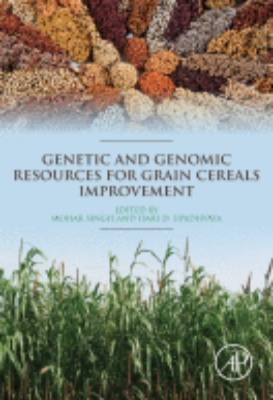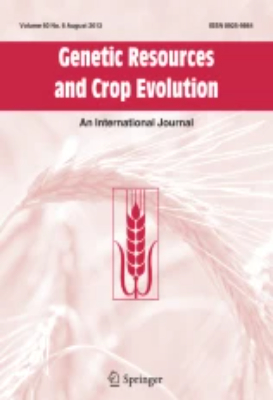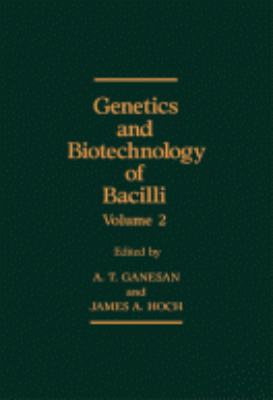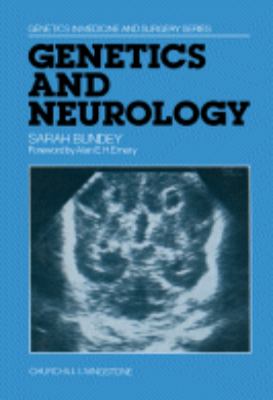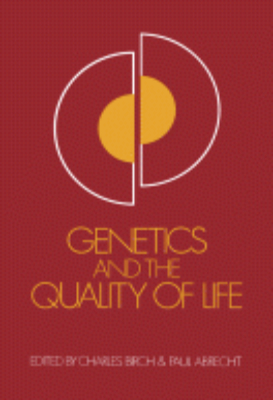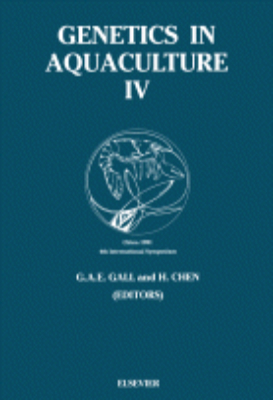E-Resources
Genetic and Genomic Resources for Grain Cereals Improvement
"Genetic and Genomic Resources For Cereals Improvement is the first book to bring together the latest available genetic resources and genomics to facilitate the identification of specific germplasm, trait mapping, and allele mining that are needed to more effectively develop biotic and abiotic-stress-resistant grains. As grain cereals, including rice, wheat, maize, barley, sorghum, and millets constitute the bulk of global diets, both of vegetarian and non-vegetarian, there is a greater need for further genetic improvement, breeding, and plant genetic resources to secure the future food supply. This book is an invaluable resource for researchers, crop biologists, and students working with crop development and the changes in environmental climate that have had significant impact on crop production. It includes the latest information on tactics that ensure that environmentally robust genes and crops resilient to climate change are identified and preserved. Key Features. Provides a single-volume resource on the global research work on grain cereals genetics and genomics. Presents information for effectively managing and utilizing the genetic resources of this core food supply source. Includes coverage of rice, wheat, maize, barley, sorghum, and pearl, finger and foxtail millets"
Genetic Engineering of Crop Plants
Genetic Engineering of Crop Plants is a proceeding of The 49th Nottingham Easter School in Agricultural Science, which was held at Sutton Bonington on April 17-21, 1989. This symposium discussed progress in the generation of crop species resistant to herbicides, viruses, and insects. The book discusses topics such as the genetic manipulation in plants; genetic engineering of crops for insect and herbicide resistance; the expression of heat shock gene in transgenic plants; and tuber-specific gene expression. The book also covers topics such as regulation of gene expression in transgenic tomato plants; the molecular biology of pea seed development; and the regulatory elements of maize storage protein genes. The text is recommended for experts in the field of botany, agriculture, and genetics who would like to know more about the improvement of crop plants through genetics.
Genetically Modified Plants
"A transgenic organism is a plant, animal, bacterium, or other living organism that has had a foreign gene added to it by means of genetic engineering. Transgenic plants can arise by natural movement of genes between species, by cross-pollination based hybridization between different plant species (which is a common event in flowering plant evolution), or by laboratory manipulations by artificial insertion of genes from another species. Methods used in traditional breeding that generate transgenic plants by non-recombinant methods are widely familiar to professional plant scientists, and serve important roles in securing a sustainable future for agriculture by protecting crops from pest and helping land and water to be used more efficiently. There is worldwide interest in the biosafety issues related to transgenic crops because of issues such as increased pesticide use, increased crop and weed resistance to pesticides, gene flow to related plant species, negative effects on nontarget organisms, and reduced crop and ecosystem diversity. This book is intended to provide the basic information for a wide range of people involved in the release of transgenic crops. These will include scientists and researchers in the initial stage of developing transgenic products, industrialists, and decision makers. It will be of particular interest to plant scientists taking up biotechnological approaches to agricultural improvement for developing nations. Key Features. Discusses traditional and future technology for genetic modification. Compares conventional non-GM approaches and genetic modification. Presents a risk assessment methodology for GM techniques. Details mitigation techniques for human and environmental effects"
Genetics and Biochemistry of Antibiotic Production
* Emphasizes the molecular genetics of antibiotic production * Provides the latest information on the organization of genes encoding the biosynthetic pathway * Explores the mechanisms governing their expression and regulation * Examines the role of resistance genes in protecting organisms from their own lethal productsGenetics and Biochemistry of Antibiotic Production brings together the most up-to-date information on the genetic and biochemical mechanisms involved in antibiotic production. A collection of internationally recognized authors provide the latest information on the organization, function and regulation of genes responsible for antibiotic synthesis in a range of bacteria. This unique book groups antibiotics according to their biosynthetic affiliation, providing a background into evolutionaryrelationships while raising intriguing questions about the raison d'etre of antibiotics in nature.
Genetics and Biotechnology of Bacilli: Volume 1
Genetics and Biotechnology of Bacilli contains the proceedings of the Second International Conference on Genetics and Biotechnology of Bacilli, held at Stanford University in Stanford, California, on July 6-8, 1983. Contributors discuss the progress that has been made concerning the genetics and biotechnology of Bacillus and focus on topics built around the themes of chromosomal organization, secretion, transcription, gene cloning, gene expression, and synthesis of sporulation-associated products. This text is organized into 33 chapters and begins with an overview of bacteriophage lambda biology, with emphasis on lambda insertion, controlled DNA rearrangements, operator-promoter function, and the evolution of extrachromosomal elements. The reader is then introduced to genetic mapping of cloned ribosomal RNA genes, gene amplification in Bacillus subtilis, beta-lactamases of Bacilli, and the role of a Bacillus secretion vector in the secretion of foreign gene products. This book also gives an account of various facets of Bacillus biology, especially in the identification of promoters, cloning of foreign genes, and selection of expressed gene products. This reference material is a valuable resource for geneticists, microbiologists, and biotechnologists, as well as students and researchers in the fields of molecular biology and biochemistry.
Genetics and Biotechnology of Bacilli: Volume 2
Genetics and Biotechnology of Bacilli, Volume 2 is a collection of papers from the "Fourth International Conference on Bacilli" held in California on June 21-24, 1987. One paper reviews the results of cloning and characterization of genes for secreted enzyme and of genes that control the expression of secreted enzymes in relation with other prokaryotic regulatory systems. Other papers tackle the regulation of gene expression during sporulation, the sigma factors, bacterial toxins, and antibiotic resistance genes. One paper reports that three genes responsible for the code for peptides found in BT cuboidal crystals have been successfully cloned. The three codes have different toxic characteristics in relation to tobacco hornworm larvae or mosquito larvae. Other papers examine replication. Such examination pertains to the two levels of control on the chromosome involved in DNA replication, or to the possible functional importance that several membranes associated DNA subcomplexes can have in Bacillus subtilis, where one of these appear to control initiation. Other papers discus secretion and extracellular enzymes, as well as, the different genetic systems and methods. This collection can prove beneficial for biochemists, micro-biologists, cellular researchers, and academicians involved in the study of cellular biology, microchemistry, or toxicology.
Genetics and Biotechnology of Bacilli: Volume 3
Genetics and Biotechnology of Bacilli, Volume 3 covers the proceedings of the Fifth International Conference on Genetics and Biotechnology of Bacilli, held on July 9-12, 1989 at the Asilomar Conference Center, Pacific Grove, California. It summarizes the remarkable progress made in the genetics and biotechnology fields of Bacilli. It is organized into four parts, encompassing 43 chapters, which focus on gene regulation and structure, enzyme structure, Bacillus thuringiensis toxins, and stationary phase gene regulation. Part I covers topics related to gene regulation and structure of Bacilli, such as control of gene expression, mutation, genetic organization, DNA sequence analysis, and identification of transcript units. It also discusses gene replication in Bacillus subtilis plasmids, levanase operon of B. subtilis, and characterization of global regulon in B. subtilis. The next part of this book focuses on the structure of various enzymes found in B. subtilis, including alpha amylases, subtilisin, alkaline phosphatase, and levansucrase. Part III discusses the generation of functional B. thuringiensis toxin hybrid genes, regulation of crystal protein gene promoters, toxicity of B. thuringiensis delta-endotoxin, and insecticidal activity of chimeric protoxins. The concluding part covers the aspects of signal transduction, regulation of differential gene expression during B. subtilis sporulation, and gene cloning and deletion for extracellular proteases of B. subtilis. It also discusses genetic and biochemical aspects of protein phosphorylation; properties of B. subtilis spores; control of stationary phase gene expression; and the novel regulatory gene, senS, of B. subtilis. This book is a valuable source of information for microbiologists, research biologists, and Bacilli enthusiasts.
Genetics and Evolution of Infectious Disease
Genetics and Evolution of Infectious Diseases is at the crossroads between two major scientific fields of the 21st century: evolutionary biology and infectious diseases. The genomic revolution has upset modern biology and has revolutionized our approach to ancient disciplines such as evolutionary studies. In particular, this revolution is profoundly changing our view on genetically driven human phenotypic diversity, and this is especially true in disease genetic susceptibility. Infectious diseases are indisputably the major challenge of medicine. When looking globally, they are the number one killer of humans and therefore the main selective pressure exerted on our species. Even in industrial countries, infectious diseases are now far less under control than 20 years ago. The first part of this book covers the main features and applications of modern technologies in the study of infectious diseases. The second part provides detailed information on a number of the key infectious diseases such as malaria, SARS, avian flu, HIV, tuberculosis, nosocomial infections and a few other pathogens that will be taken as examples to illustrate the power of modern technologies and the value of evolutionary approaches.
Genetics and Molecular Biology of Muscle Adaptation
This title is directed primarily towards health care professionals outside of the United States. It starts with the origin of life and ends with the mechanisms that make muscles adapt to different forms of training. In between, it considers how evidence has been obtained about the extent of genetic influence on human capacities, how muscles and their fibres are studied for general properties and individual differences, and how molecular biological techniques have been combined with physiological ones to produce the new discipline of molecular exercise physiology. This is the first book on such topics written specifically for modules in exercise and sport science at final year Hons BSc and taught MSc levels.
Genetics and Morphogenesis in the Basidiomycetes
Genetics and Morphogenesis in the Basidiomycetes documents the proceedings of a symposium on Genetics and Morphogenetic Studies of Basidiomycetes held during the Second International Mycological Congress. The symposium was organized as a memorial symposium to honor the many contributions of John Robert Raper, which included the hormonal control of sexual development in fungi; the biological effects of beta radiation; and the genetic control of the incompatibility systems and morphogenesis of sexuality in higher basidiomycetes. The contributions made by researchers at the symposium include studies on control of development by genes of the incompatibility system; the genetic structure of the incompatibility factors of the higher basidiomycetes; and meiosis and recombination in basidiomycetes. Subsequent chapters deal with the evolution of incompatibility; the incompatibility system as a model for the regulation of cell differentiation; morphogentic processes in Schizophyllum commune and Coprinus lagopus; and the regulatory processes which control fruiting.
Genetics and Neurology
Genetics and Neurology focuses on disorders that affect the nervous system, including atrophies, neuropathies, and tumors. The book first examines malformations of the central nervous system, phacomatoses and tumors, and cerebral degenerative disorders of childhood. Topics include malformations of the corpus callosum and neighboring structures; abnormalities of closure of neural tube; spongiform leucodystrophy; and tumors of the nervous system. The text then takes a look at extrapyramidal disorders and dyskinesias and muscle disorders. The publication elaborates on spinal muscular atrophies (SMAs), cerebellar and spinocerebellar ataxias, and hereditary neuropathies. Discussions focus on hereditary motor and sensory neuropathies of infancy and early childhood; peripheral neuropathies and lipid disorders; and congenital cerebellar ataxias. The book also discusses spastic paraplegias and multifactorial inheritance and neurological diseases. The text is a valuable reference for readers interested in genetics and neurology.
Genetics and the Behavior of Domestic Animals
"Behavior is shaped by both genetics and experience--nature and nurture. This book synthesizes research from behavioral genetics and animal and veterinary science, bridging the gap between these fields. The objective is to show that principles of behavioral genetics have practical applications to agricultural and companion animals. The continuing domestication of animals is a complex process whose myriad impacts on animal behavior are commonly under-appreciated. Genetic factors play a significant role in both species-specific behaviors and behavioral differences exhibited by individuals in the same species. Leading authorities explore the impact of increased intensities of selection on domestic animal behavior. Rodents, cattle, pigs, sheep, horses, herding and guard dogs, and poultry are all included in these discussions of genetics and behavior, making this book useful to veterinarians, livestock producers, laboratory animal researchers and technicians, animal trainers and breeders, and any researcher interested in animal behavior. Key Features. Includes four new chapters on dog and fox behavior, pig behavior, the effects of domestication and horse behavior. Synthesizes research from behavioral genetics, animal science, and veterinary literature. Broaches fields of behavior genetics and behavioral research. Includes practical applications of principles discovered by behavioral genetics researchers. Covers many species ranging from pigs, dogs, foxes, rodents, cattle, horses, and cats"
Genetics and the Quality of Life
Genetics and the Quality of Life covers the papers and report of a consultation on Genetics and the Quality of Life, held in Zurich on June 25-29, 1973, organized by the sub-unit on Church and Society of the World Council of Churches in cooperation with the Christian Medical Commission. The book focuses on the interrelation of genetics and quality of life. The selection first elaborates on genetics and moral responsibility and ethics and the new biology. Discussions focus on breakdown of values, genetically determined debility versus socially determined debility, ethical problems, and genetic inequality and moral responsibility. The text then examines ethical issues raised by eugenics, judging the social values of scientific advances, ethical problems raised by genetics, and problems raised by eugenics in Africa. Topics include the right to an adequate physical and mental endowment, genetic engineering, euphenics, constraints imposed by genetics, fertilization of human ova in vitro, and ethical questions in eugenics. The manuscript reviews findings on genetics and the quality of life, sociogenetic problems and public opinion, social and ethical problems in caring for genetically handicapped children, ethical problems in genetic counselling, and psychological issues in counselling the genetically handicapped. The selection is a dependable source of information for researchers interested in the connection of genetics and quality of life.
Genetics Environment and Behavior
Genetics, Environment, and Behavior: Implications for Educational Policy is a collection of papers from the "Genetic Endowment and Environment in the Determination of Behavior" workshop in New York in October 1971. The book discusses the relationships between genetic characteristics and behavior as being significant in understanding human behavior and learning. The text also considers the different approaches made by geneticists and psychologists on this subject. Several papers review, in terms of both quantitative and qualitative analysis, the role that genetics and the environment play in determining behavior. One paper explains the possible role of genetic determination in behaviors as found in mice and men that show high probabilities of heritabilities. Another paper tackles biochemical genetics and explains the evolution of human behavior by addressing the enzyme variations in human brains and the role of language and culture. The book also cites gene-environment interactions and the variability that can be found in behavior with references to the works of Ginsburg (1967) and Vale and Vale (1969). One paper comments on the future of human behavior genetics, highlighting the distinction between what should happen and what most probably will happen. This text is suitable for sociologists, behavioral scientists, geneticists, educators, and students in psychology, psychiatry, and related branches of medicine.
Genetics for Cat Breeders
Genetics for Cat Breeders, Second Edition covers the considerable advances in the practical application of genetics to cat breeding. This book is divided into nine chapters and begins with a discussion of the elementary principles of heredity. The subsequent chapters deal with the practical aspects of feline reproduction and development and the main factors in the practice of cat breeding. Other chapters examine the genetics of feline color and coat variation and breeds. These topics are followed by a review on the problem of genetic defects in cats. The last chapters considers the importance of record keeping in animal breeding, including providing an accurate record of familial relationship, information upon the phenotype characteristics and breeding performance, and a source of data for future decisions. This book will be of great value to biologists, cat breeders, and researchers.
Genetics in Aquaculture
This volume, the proceedings of the Fourth International Symposium on Genetics in Aquaculture, builds on the foundations laid down at the first symposium, held in Galway, Ireland in 1982 (Aquaculture, Volume 33), as well as those laid down at the second, held in Davis, California, USA in 1985 (Genetics in Aquaculture II), and the third, held in Trondheim, Norway in 1988 (Genetics in Aquaculture III). It addresses specific problems and developments in this field, demonstrating the tremendous breadth of research activity as well as the complexity of issues in aquaculture genetics. This book will be of great value to aquaculturists, fisheries scientists and marine biologists. (The above-mentioned proceedings of the first three conferences are still available).
Genetics of Bacterial Diversity
While other texts in this area deal almost solely with the "workhorse strain" Escherischia coli, Genetics of Bacterial Diversity is the first to deal with genetics and molecular biology of the wide range of other bacteria, which carry out a whole spectrum of important scientific, medical, agricultural, and biotechnological activities. Taking genetic diversity as its theme it illustrates a range of interesting phenomena such as genetic systems controlling pathogenicity, symbiosis, chemotaxis, metabolic characteristics, and differentiation. With each chapter written by acknowledged experts, this definitive book contains up-to-the-minute information on this rapidly developing field.Written by leading experts, this text--aimed at graduate-level students and above--describes the genetics and molecular biology of a wide range of bacteria.
Genetics of Bacterial Diversity: 1989
Genetics of Bacterial Diversity focuses on the rapidly developing field of ""non-K-12"" bacterial genetics that is largely outside the scope of other texts. The book begins with an introductory chapter that outlines the phylogenetic relationships of bacteria and the range of metabolic, behavioral, and developmental phenomena displayed by them. Two chapters then review the genetic processes found in bacteria generally, and discuss a range of genetic techniques used to analyze the various special systems described in the body of the book, respectively. Subsequent chapters deal with various special metabolic capabilities characteristic of certain groups of bacteria (light production, photosynthesis, nitrogen fixation, antibiotic production, degradation of aromatic compounds and mercury resistance); developmental processes of cell-cycle associated motility, sporulation, and specialized colonial behavior; four components of bacterial pathogenicity for animals; and pathogenic and symbiotic interactions of bacteria with higher plants. The final chapter explains some of the concepts and the progress being made in the application of population genetics to bacteria. This book may be of interest to microbiologists wishing to catch up on the genetic basis of some of the classical phenomena of bacteriology, and geneticists unfamiliar with some of the things that bacteria can accomplish.
Genetics of Bone Biology and Skeletal Disease
This book identifies and analyzes the genetic basis of bone disorders in humans and demonstrates the utility of mouse models in furthering the knowledge of mechanisms and evaluations of treatments. The book is aimed at all students of bone biology and genetics, and with this in mind, it includes general introductory chapters on genetics and bone biology and more specific disease-orientated chapters, which comprehensively summarize the clinical, genetic, molecular genetic, animal model, functional and molecular pathology, diagnostic, counselling and treatment aspects of each disorder.
Genetics of Movement Disorders
Hereditary or genetic diseases featuring involuntary movements constitute a major aspect of the practice of neurology, functional neurosurgery, genetics, and many areas of basic and applied neuroscience research. Describing the current knowledge on these disorders, Genetics of Movement Disorders brings together information essential for clinicians, geneticists, and neuroscientists in one source. Utilizing a convenient and accessible format, the book is designed to allow easy identification of relevant information, with the overall organization of topics following established phenotypic classifications of movement disorders such as Parkinsonian syndromes, chorea, ataxia, and major categories of diseases grouped by gene locus. This book broadly appeals to neurologists, neuroscientists, geneticists, as well as cell and molecular biologists and hematologists.
Genetics of Reproduction in Sheep
Genetics of Reproduction in Sheep is a compilation of papers that are concerned with the study and application of genetics to the reproduction in sheep. The book is divided into six parts, grouping the papers according to topic. The main topics include genetic variation and selection; the inheritance and the effects of the Booroola gene; genetic strategies for single genes; physiology of genetic variation; the physiological criteria of genetic merit; and the national requirement and systems of husbandry. The text is recommended for those involved with raising sheep and plan to apply genetics in their reproduction, as well as for geneticists who wish to conduct studies on how their field is applied to sheep reproduction.
Genetics of Sex Differentiation
Genetics of Sex Differentiation intends to help readers understand the genetic basis of sex differentiation. The book focuses on explaining how the sex chromosomes affect the process of sex differentiation by influencing the rates at which cells divide. The book is composed of seven chapters. It provides overviews of classical genetics and structure of cells. It also explains the chromosomal basis of sex determination and sex determination using Drosophila. Polygenetics and continuous and quasicontinuous variations are also discussed. The book also discusses sex factors, determination, and disorders. Moreover, it explains the heterochromatin, embryological basis of sex differentiation, and triploidy and autosomal effects. In addition, it discusses the relationship of genes, chromosomes, growth, and sex. The book is an excellent ""bedside book"" for students in biology, specifically in genetics and developmental biology. Lecturers and professionals in biology and genetics will also find this book invaluable for their practice.
Genetics of the Norway Rat
Genetics of the Norway Rat details the various genetic traits of Norway rat. The book covers a wide spectrum of trait inheritance, from color variation up to the various genetic mutation and quirks. The coverage of the text includes growth, metabolism, reproduction, and endocrinology. Several chapters also cover the physiological traits that include skeleton, viscera, sensory organs, and nervous. The text also takes into consideration the immunogenetics, pharmacogenetics, psychogenetics, and cytogenetics of the species studied. The book will be of great interest to mammalian geneticists. Researchers who are using rats as a test subject in their research will also benefit from the text.
Genetics Structure and Function of Blood Cells
Genetics, Structure and Function of Blood Cells contains the proceedings of the symposia of the 28th International Congress of Physiology held in Budapest between 13 and 19 of July, 1980. Organized into six parts, this book begins with a discussion on the genetic regulation of hemoglobin synthesis. Parts II and III describe the immunoglobulin receptors and their effectors, and antenatal development of human blood cells. Subsequent parts talk about regulation of differentiation of hemoglobin structure and function and the role of calcium in red cell membrane transport processes. The last part elucidates the structure and function of blood cell membranes.

